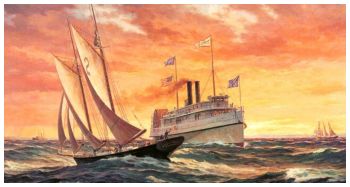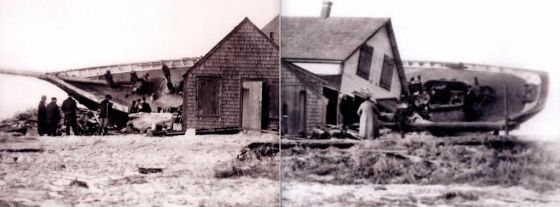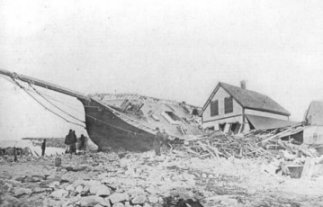Yves GARY Hits: 6274
Category: COLUMBIA 1871
 The Final Voyage of the Portland
The Final Voyage of the PortlandOn November 27, 1898, the steamer Portland departed Boston for her scheduled run to Portland, Maine. She was never seen again. That evening a storm arose in the waters off New England. Before it abated the following day, hundreds of vessels and shore properties were damaged.
The Portland was lost with no survivors, and that storm has come to be known as "The Portland Gale."
Although not successful, the rescue efforts of the pilot boat Columbia give a glimpse into these heroics....
 26 Nov. 1898 : the schooner Columbia that was blown onto the beach at Scituate in a storm. |
 Pilot boat Columbia in 1938 on beach at Scituate, MA |
|
The Final Voyage of the PortlandOn November 27, 1898, the steamer Portland departed Boston for her scheduled run to Portland, Maine. She was never seen again. That evening a storm arose in the waters off New England. Before it abated the following day, hundreds of vessels and shore properties were damaged. The Portland was lost with no survivors, and that storm has come to be known as "The Portland Gale."
During the height of the Portland Gale, men like Joshua James were busy all over the bay from North Scituate to Fourth Cliff, from Point Allerton to Brant Rock and Gamet Stations, from Cape Ann to Race Point. Although not successful, the rescue efforts of the pilot boat Columbia give a glimpse into these heroics. In 1898, there were eight pilot boats that searched the waters off Boston for incoming vessels requiring a pilot to navigate them past the harbor's many hazards. One of these vessels, the Columbia, eighty-five feet long and eighty-nine tons, was a particularly pleasing boat with a clipper-type stern. Manned by a crew of five, with four pilots ready to board incoming ships, she was also considered a "lucky" vessel and had the number two stitched to her sail. The Columbia had gone on station outside Boston Harbor a few days before the gale hit. Being far offshore, she may not have been fully aware of the approaching disaster but certainly knew by Saturday evening that the weather was turning ugly. According to Ball and Freitas, hour by hour the Columbia was driven closer to the Scituate shore, eventually dropping two anchors. Brought ashore no doubt by Sunday's morning's high tide, the Columbia wrecked on Cedar Point with the lost of all crewmembers.
Testimony by lifesaving serviceman Richard Tobin who passed by the spot where the Columbia crashed ashore stated: I went down to the beach to the key post three miles from the station. When I started there was much wreckage on the beach, and the seas were coming over with such force that I was washed into Mesquashout Pond. It was blowing so hard that I was obliged to kneel down at times to get my breath. It was a hurricane from the northeast, and snowing so that I could not see any distance offshore. I kept on, and I had to take the fields back to the beach. Then I was able to make better progress, and at last reached the post and then started to return. I warned a number of people in house nearby that they had better seek safety elsewhere - to a safe place in another house, and also assisted a fisherman to haul his boats away from the danger. When I was through with these things I started for the station and had to travel along the fields, it being impossible to keep on the beach. I got back to the station a little after half passed three in the afternoon.
The Saturday midnight patrols did not begin until 1:00 a.m. due to high surf. Surfman John Curran on the 4:00 a.m. sunrise patrol came upon the Columbia at the neck of Cedar Point. She was driven high on the beach, her foremast gone, the starboard side badly damaged, the anchor chains extended and anchors missing. The body of one crewman lay in the hold.
The surfman hurried back to the station and alerted George Brown, keeper, who immediately dispatched three more surfmen to the scene, where four more bodies were found. The entire crew of the Columbia was lost, most likely drowning before she reached the beach. Interestingly, Otis Barker purchased the Columbia hulk shortly after the storm and turned it in to a cottage. It remained on the beach as a tourist attraction until the early 1930s, when the rotted structure was removed. |
|
|
Pilots: Pilot schooners of North America and Great BritainColumbia, a Race in Canoes, and the "Portland Storm"Captain Cooper and his colleagues sold the Friend to the New Jersey Pilots in 1893 when she was nearing forty years of age. She was replaced by the mighty Columbia, built by Ambrose D. Martin at East Boston. Sporting an unusual bow that was almost clipper-like, she was extremely fast off the wind and more than capable of hourly runs in the fourteen-knot region. She was one of the biggest pilot schooners of her time.
Columbia was returning to Boston manned out when the so-called 'Portland Gale' struck. She was unable to claw off the land and the boatkeeper was left with no choice but to anchor. When the ground tackle failed, she was thrown ashore on the Sand Hills, endind up by demolishing a cottage. All five crew were lost, yet the schooner was left where she lay for many years as a marine curiosity. |
|
